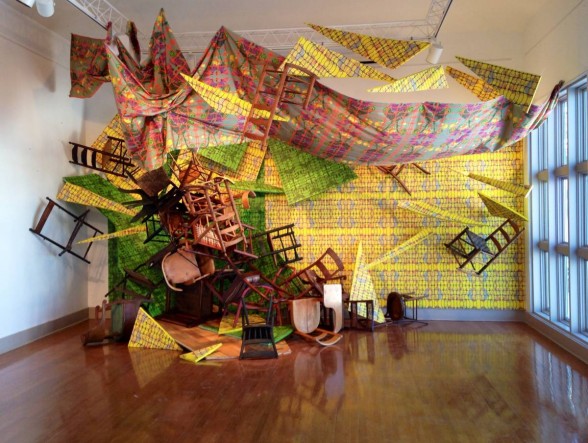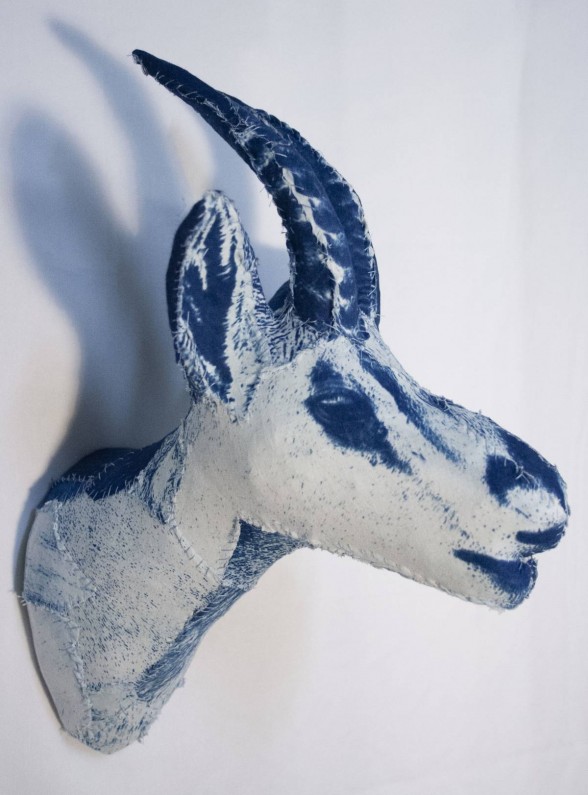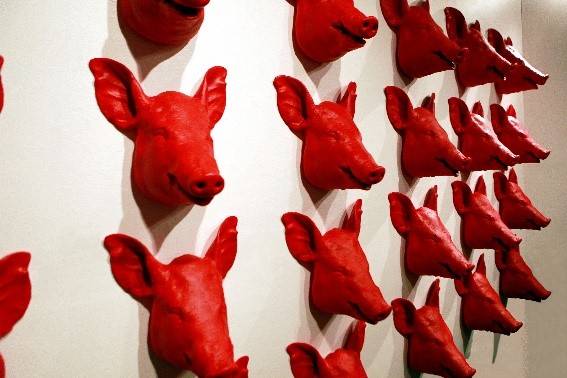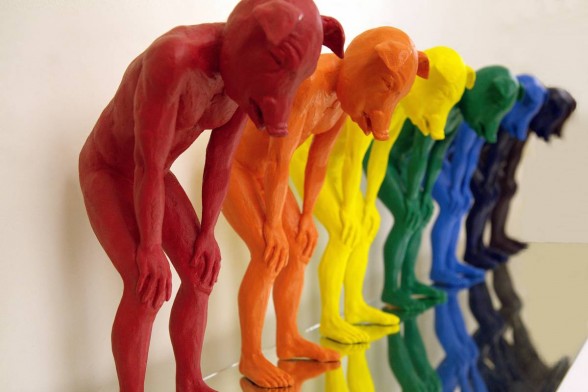[Jennifer takes a whirl around a colorful show touching on a range of natural and animal themes–but don’t expect pastoral scenes. — the Artblog editors]
Three artists grapple with nature and its forces in Tweak of Nature, the current exhibition at the Main Line Art Center. In the spacious, light-filled galleries here, we see a pile of chairs crashed together into an abstract sculptural jumble, an octopus freeing itself from beneath a bell jar, and pig-humans staring at their reflections in a mirror. In these works and others, nature is an element that is powerful, threatened, and threatening, but also an animal force of sorts imbuing varied creatures with hybrid features or the ability to defy the solidity of walls. Sculpture by Seunghwui Koo and Tasha Lewis, and paintings and installation by Kate Stewart, form this 11th Annual Betsy Meyer Memorial Exhibition.
Man versus nature

Those crashed-together chairs form “Götterdämmerung,” a word which Internet sources translate to mean “twilight of the gods” and “catastrophic collapse”; it is the largest piece in this show. For this installation, Kate Stewart extends into the gallery space much of the subject matter of her paintings, which hang nearby. In the painting titled “Cordes,” a treetop is covered with loads of what looks like wooden furniture reminiscent of the “Götterdämmerung” heap. “Stockpile” shows green shrubbery covered by white, windblown fabric.
In all of these works, it seems as though a great natural force such as a flood or tornado brought the furniture or fabric to rest where it is, forming a disheartening but familiar scene of refuse in nature. Other paintings are equally discouraging. In “Alpha State,” a camper sleeps outside while wearing a glass bubble around her head–it is presumably her only means of fresh air and a sad commentary about nature’s ruin.
Despite a clear ominousness in many works, it is at times difficult to discern whether Stewart’s investigations present nature as thriving or doomed. This uncertainty may reflect contemporary debates about the long-term viability of the natural world, or Stewart may be interjecting some hope and beauty into these catastrophes. For example, the “Götterdämmerung” installation includes swirling sections of textiles and panels printed with layers of imagery, including orange construction-site mesh that contains or cordons off the main jumble of chairs. Behind this orange mesh, Stewart has printed a dense, repeating pattern of lush, colorful flowers. The artist presents this devastation only to show us that flowers continue to encroach, grow, and bloom.

Tasha Lewis’s sculptures propose a decidedly optimistic outcome. Her cyanotype-printed textile sculptures of deer, butterflies, foxes, birds, and sea creatures are all shown breaking through a boundary or container that would otherwise hold them permanently as specimens or trophies. Deer and gazelle heads hang on the wall like taxidermy, but the addition of two front legs to one of the deer suggests that these animals are anything but lifeless; the title tells us that this animal is just “Passing Through”.
Other works show animal bodies defying limits and confines, and all are constructed with exquisite and obvious handcraft that showcases the ways that patchwork construction can provide tactile and visual richness and also celebrate ideas of mending, fixing, and creation. A beautiful example of stitchery and materials can be seen in “Qebehsenuef,” a hybrid woman-falcon who appears to be simultaneously crouching down and bending over. In a phone conversation, Lewis told me that this bent-over pose is inspired by the role Qebehsenuef plays in Egyptian mythology–he is a chimera figure usually seen on funerary jars guarding the intestines of the deceased. The pose here puts focus on the site of the intestines and even the anxiety that is often felt in that bodily location, Lewis said. Seen within the context of the other boundary-defying animals in this gallery, this mythic, gender-bending, hybrid creature also evokes a rebellious power.
Swine signs

Hybrid animal-humans are a central subject and repeating form in the many sculptures by Korean-born Seunghwui Koo, who uses pigs, pig heads, or pig-headed humans to explore themes of wealth, luck, and greed. This mash up of pig/human presents an uncanny strangeness. Scale is interesting too. There are lots of cute, tiny pigs on small shelves, each one with a symbol–a heart or a Band-Aid, for example–painted onto its haunches. According to the artist, these small sculptures represent the many varied inhabitants of New York City, where Koo lives.
Larger, menacing pigs repeat in “New Yorker,” a wall-sized installation of bright red pig heads hung in a grid. If the many small pigs represent a lighthearted and colorful diversity, then “New Yorker” suggests an opposite: maybe something like a cookie-cutter conformity or an oppressive stubbornness associated with pigheadedness. The dichotomies here echo different cultures’ associations of pigs. In Korean culture, pigs represent good luck and wealth, while Western connotations of pigs include greed and stubbornness.

“Narcissism” presents six rainbow-colored figures peering down into a mirror, but rather than falling in love with their own reflections as Narcissus did, these figures seem exhausted and perplexed. Maybe they carry some of the burden that the overbearing red heads in “New Yorker” impose. Koo manages to sculpt a believable sense of worry into each hand-built pig face in “Narcissus”. Indeed, each of Koo’s sculptures is individually modeled, rather than mold-made, and viewers can look for a uniqueness among the many repeating forms.
All of the work in Tweak of Nature, in fact, is a delight to look at closely. These sculptures, paintings, and installation all strike a balance between epic themes–natural forces, wild animals, big cities–and the fine, detailed particulars of art-making.
Tweak of Nature, the 11th Annual Betsy Meyer Memorial Exhibition, is on view at the Main Line Art Center through April 21, 2015. During the month of April, each of the artists will present hands-on artist workshops inspired by their work and ideas.









